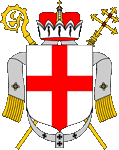mobile View, to the German Version tap the flag


- Electorate and Archbishopric of Trier
- former country of the Holy Roman Empire of German Nation
- to 1794 fully sovereign
- from 1815 in the main parts to Prussia
• Flag
• Meaning/Origin of the Flag
• Coat of Arms
• Meaning/Origin of the Coat of Arms
• Numbers and Facts
• History
• Origin of the Country's Name

Flag of the Electorate and Archbishopric of Trier,
Source, by: Wikipedia (EN)





The flag of the Archbishopric of Trier is a scutcheon-flag. It shows the image of the blazon of the Archbishopric of Trier, a red cross on white (silver).
Source: Wikipedia (EN)


Lesser coat of arms of the Electorate and Archbishopric of Trier

The coat of arms of the Electorate and Archbishopric of Trier shows a red, sometimes cut red cross, that extends to the edge of the coat of arms. It goes back to a cruise by Low German crusaders in 1217. The Pope often gave cross flags for crusades, in varying color combinations for contingents, which could also be assembled nationally. Ecclesiastic and secular marks of dignity were added to the coat of arms later. The title of prince bishop and the use of the with that combined marks of dignity (prince's hat, prince's mantle) was abolished in 1951 by Pope Pius XII.
Source: Volker Preuß,
Wikipedia (D)

Area: ca. 1 150 square miles
Capital: formally Trier (Trèves) to 1629, later Ehrenbreitstein and Koblenz

Ancient · settlement by the Celtic tribe of the Treverer
ca. 30 B.C. · the area was conquered by Roman troops, to the province of Germania Inferior, the Romans establish a military base
ca. 16 B.C. · the Romans found the place 'Augusta Treverorum'
3rd century · Diocese of Augusta Treverorum (the seat of a bishop)
275 · invasion of the Alemanni
293–392 · the meanwhile 'Treveris' called city is one of the residences of the Roman emperor
328–340 · 'Treveris' is the residence of the Roman Emperor Constantine II.
367–392 · 'Treveris' is again the residence of the Roman Emperors
395 · at the division of the Roman Empire the Treveris area came to the West Roman Empire
406 · invasion of the Vandals
413 · invasion of the Franks
421 · invasion of the Franks
451 · invasion of the Huns
455 · invasion of the Franks
475 · invasion and final conquest by the Franks, the region comes to the Frankish Empire
870 · Treaty of Meersen, division of the Frankish Empire, Trier comes to the East Frankish Empire (the later German Empire)
902 · The archbishops become the Counts of Trier (upper Archdiocese)
1018 · Emperor Henry II. grants the Frankish Royal Court in Koblenz to the Archbishop (lower Archdiocese)
12th to 13th century · territorial growth at the expense of the Palatine Counts of the Rhine (Palatinate), the archbishops of Trier become electors (for the royal election legitimated prince)
14th century · territorial growth, connecting of the upper and lower Archdiocese
16th century · acquisition of Virneburg and Pruem
1629 · the archbishops and electors of Trier move their residence to Ehrenbreitstein
1786 · the archbishops and electors of Trier move their residence to Koblenz
1684–1697 · Palatinate War of Succession, French troops occupy and ravage the country
1794 · invasion of the French revolutionary army, the archbishopric loses its independence
1801 · the Archbishopric and Electorate becomes dissolved, all the left-bank territories ceded to France and incorporated by this
1803 · German Mediatisation (Reichsdeputationshauptschluss), the right-bank areas come to the Duchy of Nassau-Weilburg
1806 · end of the Holy Roman Empire of German Nation
1815 · Congress of Vienna, nearly all the territories of the former Archbishopric of Trier come to Prussia, to the province of Juelich-Kleve-Berg (from 1822 Rhine Province)
1947 · the state of Prussia becomes eliminated by the Allies, the Rhineland is annexed to the newly created States of North Rhine-Westfalia and Rhineland-Palatinate
Source: Wikipedia (D),
Atlas zur Geschichte,
Discovery '97

The Electorate and Archbishopric of Trier was named after the city of trier, the seat of the archbishops (to 1629). At the Romans founded the place was called "Augusta Treverorum" which translated means "Place of Augustus in the Land of the Treverer Tribe". About the year 50 A.D. the settlement was awarded the city law. Therefore it was renamed in "Colonia Augusta Treverorum", what can be translated with "Settlement of Augustus in the Land of the Treverer Tribe". However, in practice, "Augusta Treverorum" retained. Some 200 years later the city was only called "Treveris", later this changed to "Trier".
Source: Wikipedia (D)







![]()





